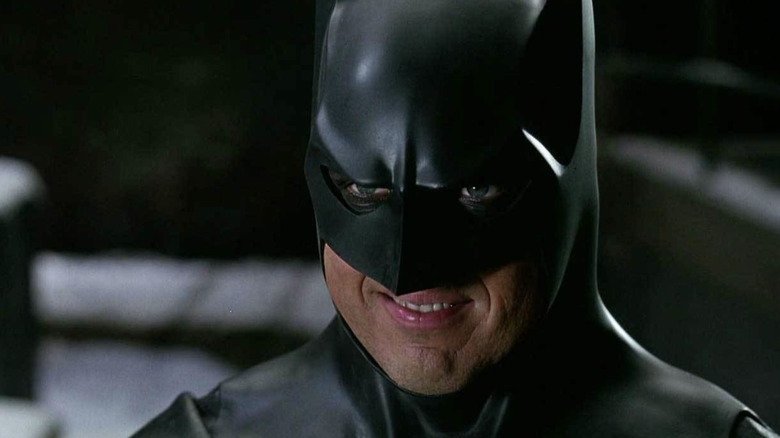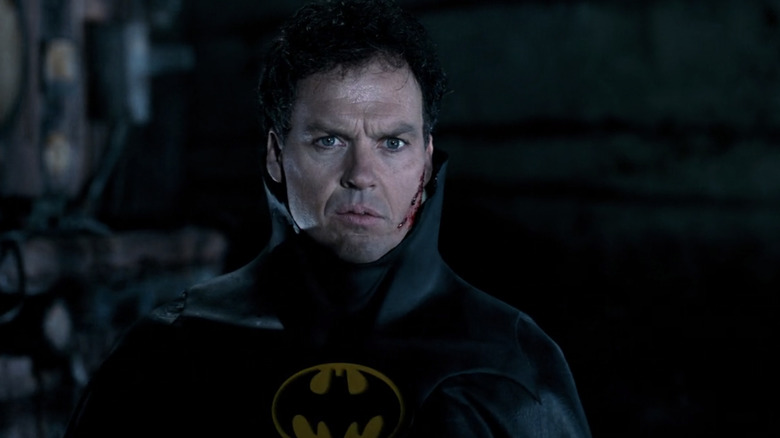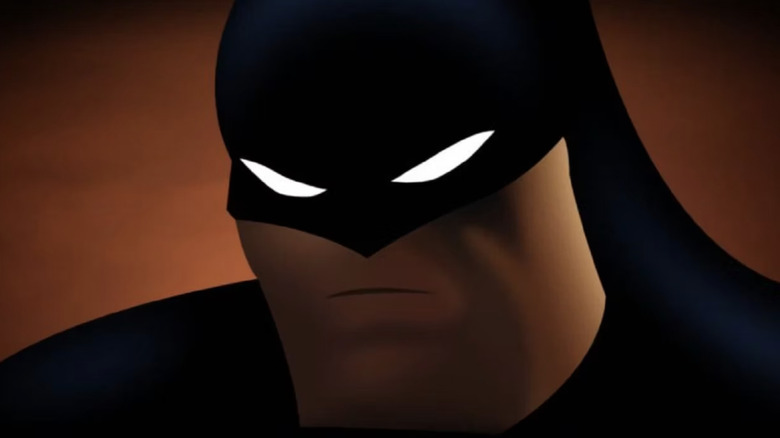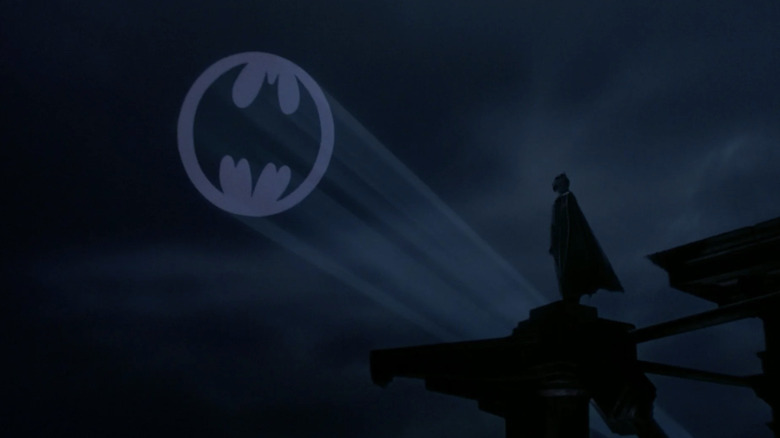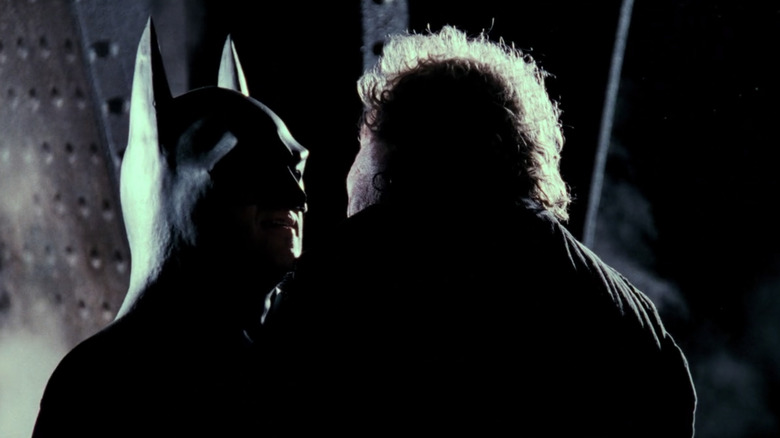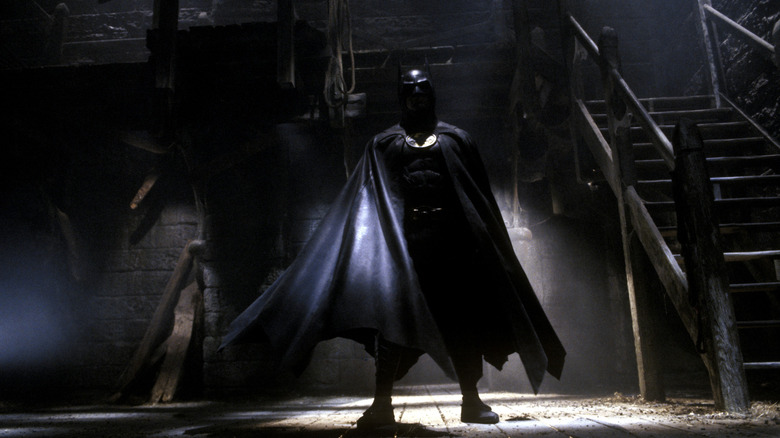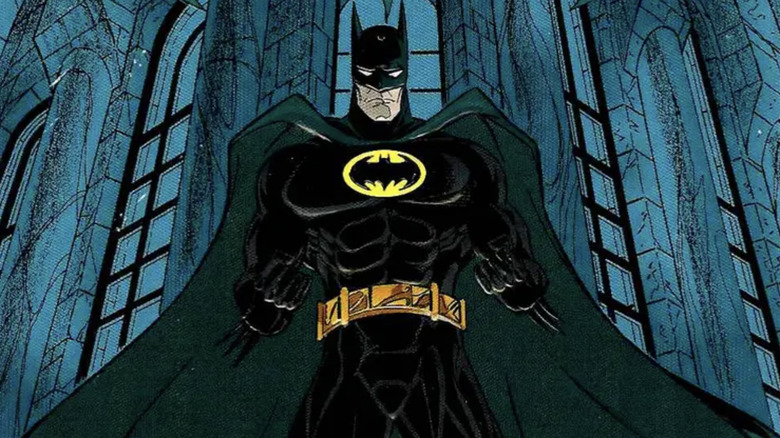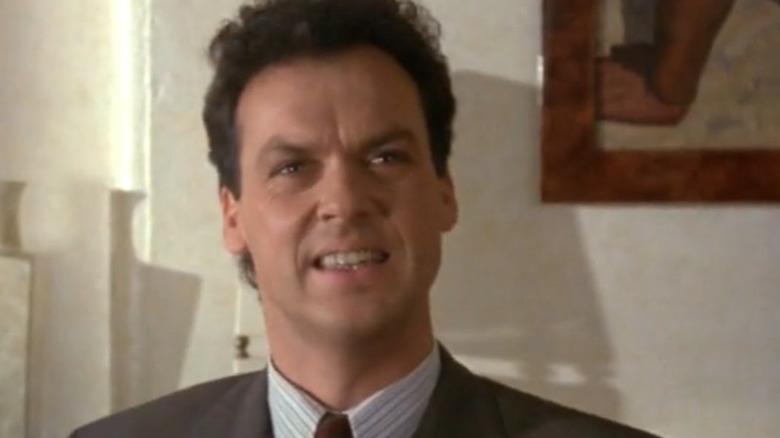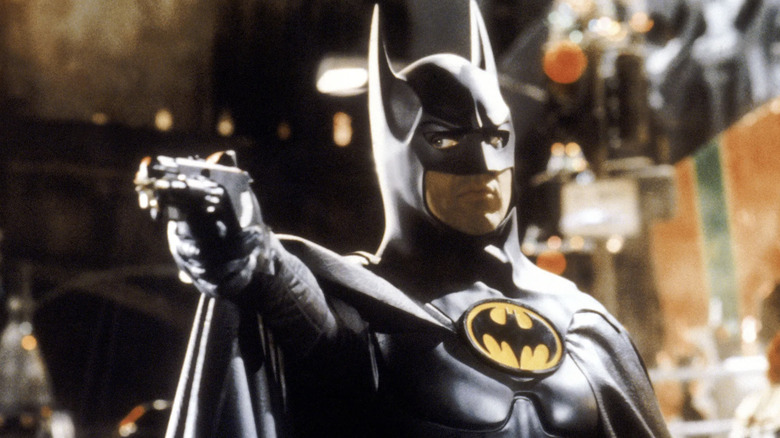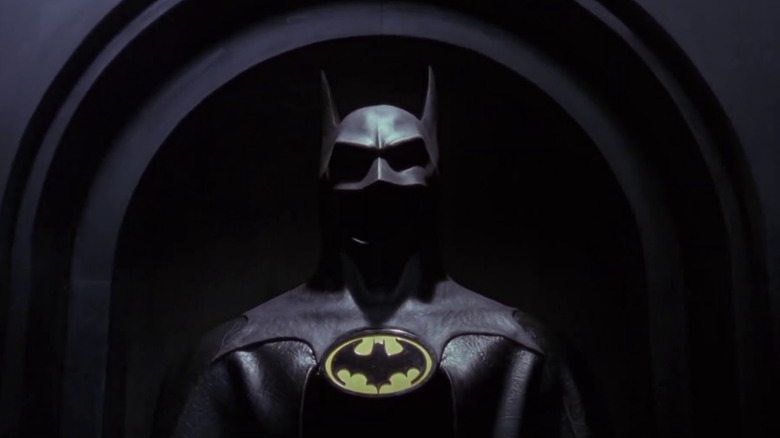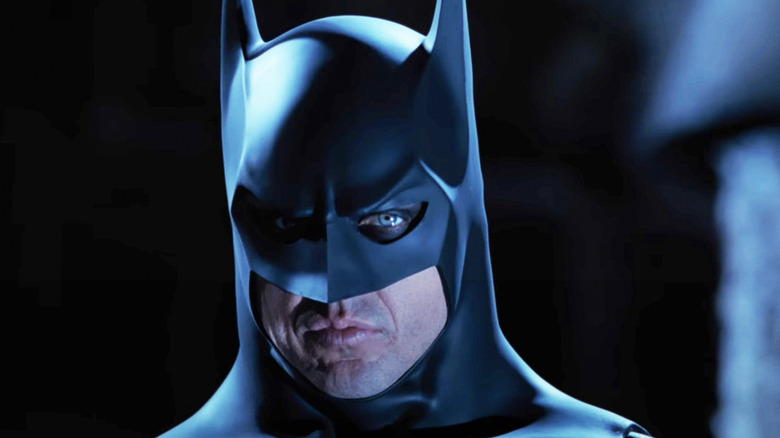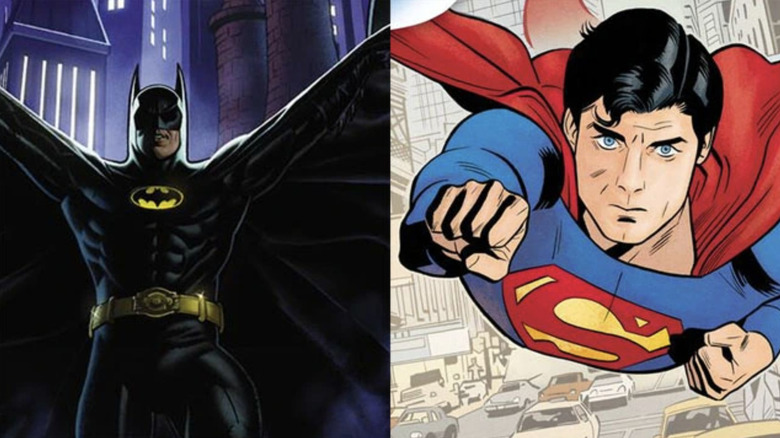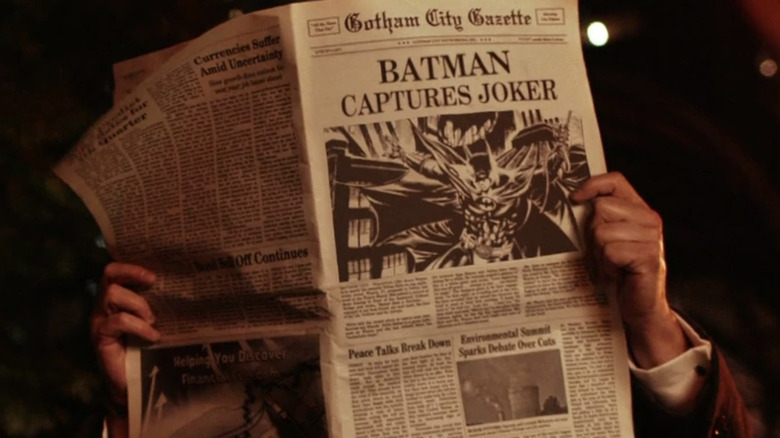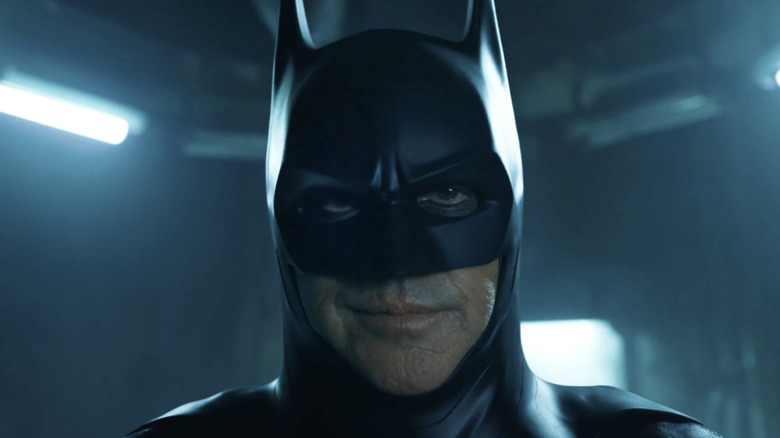The Untold Truth Of Michael Keaton's Batman
The year is 1989. Batman is everywhere. After years of television reruns highlighting the Adam West caricature, "Beetlejuice" and "Mr. Mom" star Michael Keaton is headlining a darker reimagining of the character. With director Tim Burton at the helm with his distinctly gothic aesthetic, the feature film "Batman" is about to redefine everything a comic book or superhero movie could be. While there are plenty of great Batman movies out there, Burton's "Batman" stands in a category all on its own, and kickstarted a craze unlike any other.
Before he was cast as Batman, Michael Keaton was primarily known for his work in comedies, a genre he'd return to time and again following his tenure under the cape and cowl. But the Dark Knight always stuck with him, and many have since considered Keaton's Batman as one of the best live-action iterations of the character. Despite only playing the Caped Crusader twice, Keaton's Batman has become so legendary that his appearance in 2023's "The Flash" has been met with more fanfare than the Fastest Man Alive could ever hope to find.
For over 30 years, the '89 version of Batman has captivated the hearts and minds of an entire generation and influenced the future of the Dark Knight in more ways than one. Yes, Michael Keaton is Batman, and he's a Batman unafraid to dance with the devil in the pale moonlight. If the classic movie Batman is your favorite depiction, then buckle up because Gotham City is waiting.
Michael Keaton loves playing Batman
Not every actor enjoys playing a superhero. Between the elaborate costuming, the grueling hours, and the publicity that goes with the cape, cowl, or suit of armor, it could be easy to get sick of the heroics. Keaton, however, loves playing the Caped Crusader. According to Den of Geek, Keaton's long-anticipated return in "The Flash" happened just because the actor just thought it would be fun.
"[I] was curious what it would be like after this many years," Keaton remarked about his 2023 return, which comes over 30 years after "Batman Returns." When talking with Jimmy Fallon on The Tonight Show, Keaton noted that putting on the bat suit again was just like riding a bike. Unlike some actors who avoid talking about their time as a superhero, Keaton has never shied away from his time as Batman. "I'm proud of the choice I made, in terms of how to play Batman," he told ShortList while promoting "Birdman" in 2014.
When later asked if he was jealous of Ben Affleck's casting as Batman (after Christian Bale had admitted as much), Keaton dismissed the notion. "No. Do you know why? Because I'm Batman. I'm very secure in that." Now, almost a decade later, he and Affleck both appear in "The Flash" as their respective Batmen. Hopefully, this won't be the end for either hero.
He paved the way for Batman: The Animated Series
Without the success of Michael Keaton's portrayal, "Batman: The Animated Series" would likely not exist. Though the Dark Knight's most iconic animated adventures aren't a continuation of the live-action films, Keaton's Batman and Burton's vision of Gotham City were the templates for which Warner Brothers wanted to capitalize on the success of "Batman."
It's no mistake that the animated series premiered only months after the release of "Batman Returns," nor that the character designs for Joker and Penguin are eerily similar to their theatrical counterparts. The Joker is even called "Jack Napier," his alter-ego when played by Jack Nicholson, in multiple episodes. Also, the success of "Batman" ensured the animated series would be greenlit.
The gothic, Art Deco design of Gotham City is reminiscent of Burton's live-action films, and the series likewise emphasized a noir tone that was prominent in both of Keaton's live-action features. Danny Elfman, who composed the iconic "Batman Theme" for the first "Batman," even returned to compose the theme music for "Batman: The Animated Series," forever solidifying Batman's musical legacy.
Of course, Keaton's performance was another notable influence, as the actor carefully studied Bruce Wayne's psyche. Kevin Conroy did the same, forging his own distinct path in the process. Both actors played the aloof playboy exceptionally well before switching up their vocals for the Dark Knight. Though "The Animated Series" is by no means associated with live-action films, there's no denying how Keaton's Batman influenced the execution of his animated counterpart.
He reignited Batmania
There's no doubt that Batman was popular long before Michael Keaton took on the role, but his tenure as the Caped Crusader helped spark an unending wave of Batmania. Prior to the release of "Batman," the character's popularity was winding down. Though the term was coined by Billy Joe White for his own fan magazine also titled "Batmainia," it was used later to describe fan interest in the original 1960s "Batman" TV show. After the show's popularity waned, the release of the 1989 feature film reignited interest in Batman everywhere.
Cult filmmaker Kevin Smith remarked fondly about that year. "You couldn't turn around without seeing the Bat-Signal somewhere," he said. "It was just the summer of Batman, and if you were a comic book fan, it was pretty hot." Smith was right. Kids were even getting Batman-inspired haircuts in anticipation of the film's release. But die-hard fans weren't the only ones eagerly awaiting June 23, 1989. During that time, Warner Bros. reportedly sold over $500 million worth of Batman merchandise, forcing the Caped Crusader back into the general population's cultural zeitgeist.
From there, "Batman: The Animated Series" premiered, sequels were greenlit, more Batman comic books were published, and the Batmainia continued. To this day, it hasn't slowed down much, as Batman is always a consistent sell for both DC Comics and Warner Bros., who continue to release copious amounts of Bat-themed products each year.
He was the first to use a 'bat-voice'
Before Kevin Conroy switched up his vocals for Bruce Wayne and Batman, Michael Keaton was the first to use a Batman voice on camera. Prior to "Batman," all other live-action or animated incarnations of the character used the same voice in and out of costume. Somehow, nobody in the 1940s through the 1980s figured out that Batman and Bruce Wayne were one and the same. But Keaton's version of the Dark Knight changed all that, adding grit and gravitas to his spooky presence as he terrorizes the superstitious and cowardly lot that plagues Gotham City.
Keaton's technique would be adapted in animation by Kevin Conroy — who starred in his own animated Batman feature, "Batman: Mask of the Phantasm" — and eventually in Batman's subsequent live-action appearances also, though not by his immediate successors. Neither Val Kilmer of "Batman Forever" nor George Clooney of "Batman & Robin" even made an attempt at recapturing Batman's vocal disguises that Keaton laid before them.
The "Batman voice" trend wouldn't be popularized in live-action until Christian Bale's tenure in "The Dark Knight Trilogy," where his gravely vocals became infamous following "Batman Begins." After Bale's time as Batman, Ben Affleck's version used a voice modulator to hide his identity in "Batman V Superman" and the greater DCEU. Interestingly, Robert Pattinson opted not to continue Keaton's legacy, playing his Batman almost exactly like his Bruce Wayne.
He's one of the most faithful adaptations
Before "Batman" was released in theaters, the perception of the Dark Knight was vastly different than the gritty hero he's known as now. More akin to the Adam West incarnation, "Batman" comics from the 1940s through the 1960s were written with younger audiences in mind, stripping the Dark Knight of some of his, well, darker inclinations. By the '70s and '80s, DC Comics matured the Caped Crusader, publishing stories like "The Dark Knight Returns," "Batman: Year One," and "The Killing Joke," which set the tone for Batman comics for decades.
Of course, in the public eye, Batman was still often associated with the outlandish Adam West caricature, so when Michael Keaton played him as darker, grittier, and more troubled than before, it took audiences by storm. In Batman's earliest adventures, the ones still penned by co-creator Bob Kane, Batman was darker and more violent — especially before Robin showed up in "Detective Comics #38." Back then, Batman actually killed his enemies.
Though Keaton's Batman isn't a carbon copy of Kane's original vision, he doesn't stray too far from the model. Using a combination of specialized gadgets and detective skills, Keaton's Batman feels like he was ripped from the page. In many ways, he's one of the most comic-accurate portrayals of the character, especially since his Batman persona is played as Bruce's "real self."
His look was translated into the comics
Speaking of the page, Michael Keaton's live-action Batman proved so popular and culturally impressive that DC Comics adapted the 1989 "Batman" costume into the comics, but not for a few years. In the mid-1990s, Batman debuted in his new all-black outfit reminiscent of his live-action apparel. First appearing during the "Troika" story arc in 1995, this darker bat-suit landed on the cover of "Detective Comics #682" in February of that year, making Bruce Wayne's triumphant return to the cowl just in time for that summer's "Batman Forever" — which ironically featured Val Kilmer rather than Michael Keaton as Batman.
Following the long-running "Knightfall" story arc, which would later be adapted in "The Dark Knight Rises," Bruce's rebirth (clad now in all black) was the beginning of a new era for the Dark Knight. Though Batman returned to his more traditional look a few years later, he graced the DC Universe with the Michael Keaton-inspired outfit for a few years (and across a few different DC comics). But that isn't the only way that Keaton's Batman influenced the Caped Crusader's comic book appearance.
In recent issues of "Batman/Superman: World's Finest," the Dark Knight is seen wearing a very Silver Age-inspired bat suit but with one minor change. Using the same bat logo seen in the 1989 feature (the one with the extra divet at the bottom), Batman sports Keaton's live-action logo in the first issue of the ongoing 2022 series, honoring Tim Burton's original "Batman" movie.
Keaton's Bruce Wayne might not be entirely sane
It's no secret that Bruce Wayne isn't entirely balanced. After the serious trauma of watching his parents get gunned down on the streets, only to grow up to become a masked crusader dressed as a bat, it's clear that Bruce has some serious issues he's never fully worked through. To add insult to injury, his parent's killer turned out to be none other than the Joker himself, the Clown Prince of Crime who would become Batman's greatest enemy. Well, at least in the Tim Burton version.
"Why would an incredibly rich guy want to put on a weird suit and beat up petty crooks?," said "Batman" screenwriter Sam Hamm when speaking with Comics Alliance. "I mean, he'd have to be crazy, right?" The "Batman" scribe then went on to explain how the entire concept for the film centered around his and Tim Burton's desire to explore how a man like Batman could go from insane to sane. Naturally, he needed Vicki Vale to do that.
"You wanna get nuts, let's get nuts," Bruce yells at the Joker, breaking a lamp while defending Vicki Vale (Kim Basinger). This only opens the door further to questions of sanity. And let's not even mention Bruce hanging upside down in the dark in the middle of the night. While there's an argument to be made that all Batmen must be a little off their rocker, Keaton's might be the most unbalanced of the bunch.
Keaton left Batman behind after disagreements about the character
There were a lot of rumors floating around following Michael Keaton's departure from the Batman role. Christopher Reeve had played Superman in four different pictures throughout the '70s and '80s, and many expected that Keaton would do the same with the Dark Knight. Even after Tim Burton declined to tackle the Caped Crusader a third time around — only to be replaced by Joel Schumacher — Keaton was still slated to star in 1995's "Batman Forever." But that didn't last either.
According to Entertainment Weekly, "[Keaton] was worried that the character he'd lived with for two films wasn't going to be developed the way he wanted it to be developed.'" This led to the casting of Val Kilmer, who only starred as Batman for a single picture before being replaced by George Clooney in Schumacher's infamously hated sequel. Years later, after Schumacher's passing in 2020, Keaton publically elaborated on his hesitations about continuing on as Batman in the mid-90s.
"[Schumacher] asked me, 'I don't understand why everything has to be so dark and everything so sad,' and I went, 'Wait a minute, do you know how this guy got to be Batman? Have you read... I mean, it's pretty simple.'" That did it for Keaton, who walked away from Batman for over 30 years before saying yes to "The Flash." "The writing was actually really good," Keaton told Variety, proving he's simply been waiting for a good script since 1992.
Tim Burton thought the first Batman was boring
It's no secret that "Batman" was a critical and commercial success. Fans everywhere were ecstatic about the Dark Knight's blockbuster debut (the Adam West movie does not count), and the only way to go for the franchise was up. Yet, despite powerful performances from Michael Keaton and Jack Nicholson — who played a very different Joker than recent adaptations — director Tim Burton wasn't entirely happy with the end results. Of course, every movie has its hiccups, and "Batman" was no exception.
"There's parts I liked, but it was a little boring at times," the director told Empire in 1992 while promoting the sequel. Burton explained that his desire for "Batman Returns" was to treat it as if it were an entirely different film as opposed to a direct continuation. While "Returns" found cult success and is loved by many Bat-fans out there, the reaction to the movie was so mixed that Burton's initial plans for a third feature (which would've also starred Keaton) were axed altogether in favor of Schumacher's more kid-friendly vision.
While a third Burton-Keaton "Batman" would've been a sight to behold, it didn't all turn out for bad. Burton's departure, followed by Schumacher's failures, eventually led to Christopher Nolan's "Batman Begins," which kickstarted the famed "The Dark Knight Trilogy." Christian Bale, Ben Affleck, and now Robert Pattinson have had their time under the cowl, Keaton's return has brought live-action Batman full circle, even without Burton's involvement.
Keaton's Batman isn't the same as Kilmer's or Clooney's
Longtime fans of the original "Batman" anthology may disagree, but the distinction between Tim Burton's Batman universe and Joel Schumacher's couldn't be more different. For starters, their Gotham Cities look nothing alike. Where Burton's was a gritty, dark take on the DC Comics' staple, Schumacher's looked like something out of the neon era. While all four of the "Batman" anthology films feature Michael Gough as Alfred Pennyworth and Pat Hingle as Commissioner James Gordon, that's about all these two distinct worlds have in common.
Another strange shift is Harvey Dent. In Burton's world, Billy Dee Williams plays an African American version of the character who has yet to be scarred and become Two-Face. In Schumacher's version, Tommy Lee Jones plays the deformed Harvey Dent/Two-Face. The distinction speaks for itself. Aside from that, many of Batman's weaponry, vehicles, and even the Batcave itself change between "Batman Returns" and "Batman Forever," and while the films share similar continuities, they're clearly not direct continuations.
Of course, the biggest change of all is that Michael Keaton is replaced following "Batman Returns," and Val Kilmer's "Batman Forever" incarnation (though not terrible) doesn't exactly feel like the same Caped Crusader we met before. Keaton's Batman was a more tortured hero, and while Kilmer does lean into Bruce's trauma, his talent is buried under the absurdity of Schumacher's vision. And forget about trying to fit George Clooney neatly in — he barely fits Batman at all.
He shares a universe with Christopher Reeve's Superman
Aside from any fan-made trailers floating around online, you'll never see Michael Keaton's Batman or Christopher Reeve's Superman teaming up to save the world any time soon. As tragic as that is, there is still hope that their versions of the Dark Knight and the Man of Steel may work together sometime down the line. In 2021, DC Comics launched two separate limited series titled "Batman '89" and "Superman '78" to continue their stories in the same format they were originally created for, and they're awesome.
"Batman '89" followed the events of the two Tim Burton and Michael Keaton movies — completely ignoring the Joel Schumacher-directed sequels, proving that Keaton's Batman is his own separate thing — while "Superman '78" continued Richard Donner's Superman story after "Superman II." Excitingly, Batman's series was penned by original "Batman" screenwriter Sam Hamm, whose unused ideas for "Batman Returns" ended up on the page here.
While Batman and Superman never crossover during either of their limited runs, the greater DC Universe continuity brings them together. During 2022's "Dark Crisis" event, it's explained that the "Batman '89" book takes place on Earth-789, merging its universe (and the films) with the events of "Superman '78." According to DC's map of the newly minted multiverse, Superman and Supergirl — from 1984's "Supergirl" — are the only super-powered heroes of this universe, the same one where Keaton's Batman hails from. After all these years, the World's Finest finally unite.
He made his way to the Arrowverse, sort of
Okay, so Michael Keaton doesn't appear in the Arrowverse as Batman (but how cool would that have been?), but the universe he hails from actually does. In the first part of the multi-series crossover "Crisis on Infinite Earths," we see a bunch of alternate universes from live-action DC Comics history destroyed by the Anti-Monitor. Characters from the Adam West "Batman" series, "Superman Returns," the short-lived "Birds of Prey," "Smallville," and the DCEU all appear, but there was another surprise cameo that might catch "Batman" fans' eyes.
During "Part One" of the five-part event, actor Robert Wuhl returns as Gotham Gazette reporter Alexander Knox from the 1989 "Batman." Here, Knox is seen reading the paper, which claims that Batman has captured the Joker. Now, since "Batman" ends with the Joker's death after he falls from a Gotham cathedral, what gives? Well, it's not exactly a stretch to think that someone wouldn't step in and fill the Joker's shoes, or that the Clown Prince may be resurrected one day. These are comic book stories, after all.
It's worth noting that the "Dark Crisis" comic series also shows Keaton's Batman on Earth-789 (designated "Earth-89" in the Arrowverse), capturing this Joker himself. And speaking of artistic renditions, the one of the Dark Knight seen on Knox's paper is actually by legendary DC Comics artist Jerry Ordway, originally drawn for "Batman's" official comic book adaptation back in 1989. It's an excellent take on Keaton's Batman too.
He was meant to have a bigger role in the DCEU
It's no secret that Michael Keaton's return to "The Flash" was met with loads of excitement. Everyone who grew up on Keaton's "Batman" is beyond thrilled to see their favorite version of the Caped Crusader kick butt again on the big screen. After nearly 30 years, it seemed impossible that anything like this could happen, but with all the multiversal stories these days — and Hollywood's unhealthy obsession with bringing back old material — it seemed almost inevitable.
While many hoped Keaton would play an older Bruce Wayne mentoring the next Batman ala "Batman Beyond," seeing him suit up once more is equally as exciting, if not more so. In fact, for a while, it seemed like Keaton's Batman would become the next staple of the DC Extended Universe following Ben Affleck's departure, with slated appearances in the canceled "Batgirl" and potentially cut scenes from "Aquaman and the Lost Kingdom."
One thing is clear: The plan to include Keaton's Batman in the greater DCEU was a way to continue Batman's story in the wake of Affleck's absence. But, with James Gunn and Peter Safran now in charge over at DC Studios, set to wipe the slate clean, it's unclear what the future holds for Keaton's Batman. "The Flash" will have to hold us over until Michael Keaton (hopefully) returns as Batman again one day. The DC Multiverse is infinite after all.
